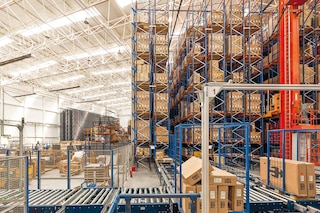
Digitalization of logistics
The rapid advance of Logistics 4.0 is driving the digital transformation of companies as they become increasingly more global. The digitalization of logistics processes, however, isn’t exactly an obstacle-free path.
In our article, we analyze the key elements of this new paradigm and the changes it’s effecting in logistics processes. We’ll set out the technologies forming part of this evolution towards a warehouse hyperconnected to the rest of the links in the supply chain.
What is digital transformation?
The concept of digital transformation refers to the implementation of new technologies in all areas of a company to improve its efficiency.Thus, digitalization in logistics constitutes the integration of new digital capabilities in fields such as storage, order prep, and transportation, among others.
The digitalization of all areas of a company is a trend that will continue in the future. It’s currently penetrating the main economic sectors, albeit at an uneven pace. According to a study by the consulting firm McKinsey, businesses are prioritizing the use of new technologies in their marketing strategies (49% have done so) and in their products and services (21%). Only 2% of those surveyed stated that they had introduced digital transformation initiatives in their supply chains.
All the same, this isn’t something the sector has disregarded. According to a Forbes Insights survey, 65% of logistics managers are aware that they need to overhaul their business model if they want to survive the digital age.

Technology enabling digitalization in the warehouse
Technology aims to achieve automated and intelligent management of a company’s documentation and of the organization of its procedures or workflows, among other things.
Nevertheless, it’s impossible to separate digital transformation processes from the technologies forming the core of the fourth industrial revolution, Industry 4.0. For context, we’ll go over the main technologies linked to digitalization in warehouse management:
- Cloud data storage: there are more and more warehouse management systems available in SaaS (software as a service, in the cloud) mode as opposed to the traditional on-premise version (in the company’s local servers). This technology calls for a lower initial investment when deploying a WMS, since you rent the license on a monthly basis instead of purchasing the entire technical infrastructure.
- IoT devices: IoT (Internet of Things) technology applied to the warehouse is closely related to the various sensors that capture information from the physical world and dump it into digital databases. Examples of this are RFID tags and motion sensors incorporated in automated systems such as stacker cranes and conveyors.
- Automation: in intralogistics operations, machines and automated systems coexist with operators as they carry out their tasks. For example, Pallet Shuttles cut back on forklift operator movements. Meanwhile, smart carts, in combination with pick-to-light systems, make for more accurate pick-to-cart operations.
- AI in logistics: artificial intelligence (AI) has made mass data analysis possible in the various links of the supply chain. For example, this interpretation of information enables demand forecasting while facilitating the management of locations in the installation and the optimization of last-mile delivery.
- Environment simulation with digital twins: this technology is extremely useful when designing a warehouse or making changes to its layout. In fact, it’s possible to test the functioning of the new organization in a digital environment before altering the way it operates in reality. Already integrated in several WMSs such as Interlake Mecalux’s Easy WMS, the digital twin application reduces the margin of error and ensures continuous process improvement.
These are some of the major trends that will revolutionize warehouse operations in the short term. All the same, new technologies and new knowledge that can make logistics processes more efficient are emerging regularly. Therefore, this is by no means a definitive list.

Digital transformation strategies: how to apply them in your logistics company
All digital transformation initiatives in logistics have to take into account each company’s particular situation, including the difficulties it faces, the opportunities in its sector, and its objectives. Therefore, it’s a good idea to take this step by step:
Establish a starting point and set your targets: the initial analysis should address the current state of the areas most affected by digitalization. These might include document management (abandoning the use of paper once and for all), available software and hardware, process organization, and the like. This study will provide the foundation for designing the objectives of your digital transformation project.
Guarantee quick budget approval: with clear priorities, internal company bureaucracy can’t be a barrier to making the technology investments required for digital transformation.
Rely on Talent 4.0: businesses should seek out workers with specialized training in supply chain management. But they should also prioritize advanced skills in the software and digitalization field.
Achieve continuous improvement: in logistics processes, it’s essential to analyze each phase and measure the results (KPIs) to make decisions that improve effectiveness.
In this sense, there are businesses that have already successfully carried out their warehouse digitalization projects. Two cases that serve as examples of digital transformation in logistics at different levels are the intelligent management of the Rent a Book installation (thanks to the deployment of a WMS) and the automation of the BH Bikes logistics center (via a miniload warehouse and stacker cranes for pallets).
A competitive advantage in the present, an obligation for warehouses of the future
It’s common to mistakenly see digitalization as a goal in and of itself; in reality, however, it’s a means to more effective business and logistics management. In fact, according to the Deloitte Industry 4.0 investment survey, the driving force behind digital transformation in companies is improved productivity, closely followed by the pressure of competition and customer requirements.
The key lies not in investing in the most eye-catching or revolutionary systems, but rather in analyzing your firm’s needs in depth and assessing the return that each innovation will provide.
At Interlake Mecalux, our professionals are equipped to install the technology necessary for your company to meet Industry 4.0 standards. If you’d like our expertise in digitally transforming your facilities and processes, don’t hesitate to contact our team of experts.
